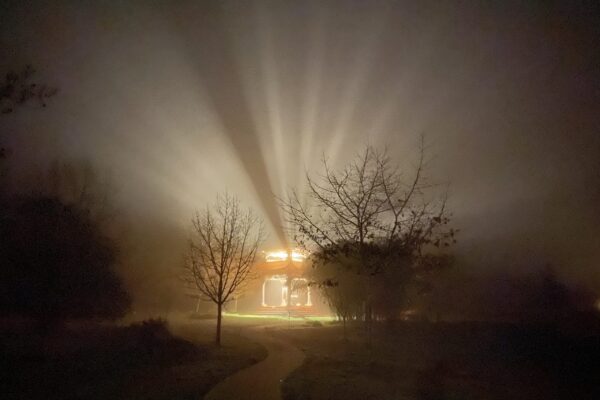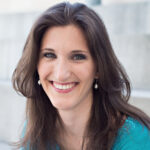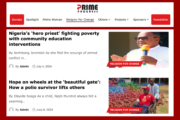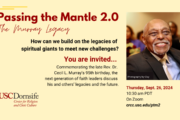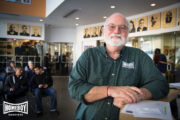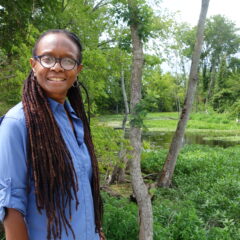This article was originally published in Mindfully Speaking, with the support of CRCC’s global project on engaged spirituality.
My mind was racing. I couldn’t sleep despite the fatigue of the first trimester of pregnancy. It was a month into the pandemic shutdown, and the next day, I had to go to the hospital.
As if balancing work, childcare and pregnancy in the middle of a pandemic was not stressful enough, a routine ultrasound had found a growth in my bladder. Its removal was essential.
I tried a meditation taught by Buddhist teacher Thich Nhat Hanh: Breathing in, I dwell in this moment. Breathing out, this is a wonderful moment.
But as I breathed in, I thought of the thousands of people in isolation, struggling for each breath in this very moment. Breathing out, I knew that life could end easily. Breathing in, I felt the fragility of my breath. Breathing out, the moment did not feel so wonderful.
Was I doing this right?
2020 has been the year of the breath. The coronavirus pandemic stole the breath of more than 300,000 Americans, while the suffocation of one man under the knee of a police officer sparked protests across the country. Widespread wildfires choked the air across the West Coast and around the world. On an everyday level, it is hard to ignore your breath each time you choose to don a mask, or not.
Meditating on one’s breath has likely helped countless people sleep at night during these long months of quarantine. But for me, it woke me up to my own and others’ suffering.
During this year of crisis after crisis, my breath became my guide. In the process, I saw how mindfulness is a tool not only of personal wellness but also social change.
A New Year’s Retreat
As 2020 began, my family and I traveled to Plum Village, a mindfulness retreat center established by Thich Nhat Hanh in France.
Even in the middle of the winter, the drive to the country retreat center was beautiful. Narrow country lanes were lined by vineyards and green pastures, and the sky was bright blue above us. The fields of grapes were dormant, and quaint towns and tasting rooms were boarded up for the winter, easing my husband, toddler and me into the slower pace of life.
 Plum Village is surrounded by vineyards and fields in the Bordeaux region of France.
Plum Village is surrounded by vineyards and fields in the Bordeaux region of France.
When we arrived, a young monk showed us and other retreatants around the grounds of the Upper Hamlet, located on the top of a hill surrounded by trees. As our tour concluded, the sunset burned a brilliant red through the trees’ barren branches. We pulled out our phones to try to capture the moment in pixels.
The monk stood silently.
We had a lot to learn.
Teacher
I went to Plum Village as a longtime admirer of Thich Nhat Hanh’s books and as a journalist reporting on the continuation of the famous Vietnamese Buddhist teacher’s legacy more than five years after he was silenced by a stroke.
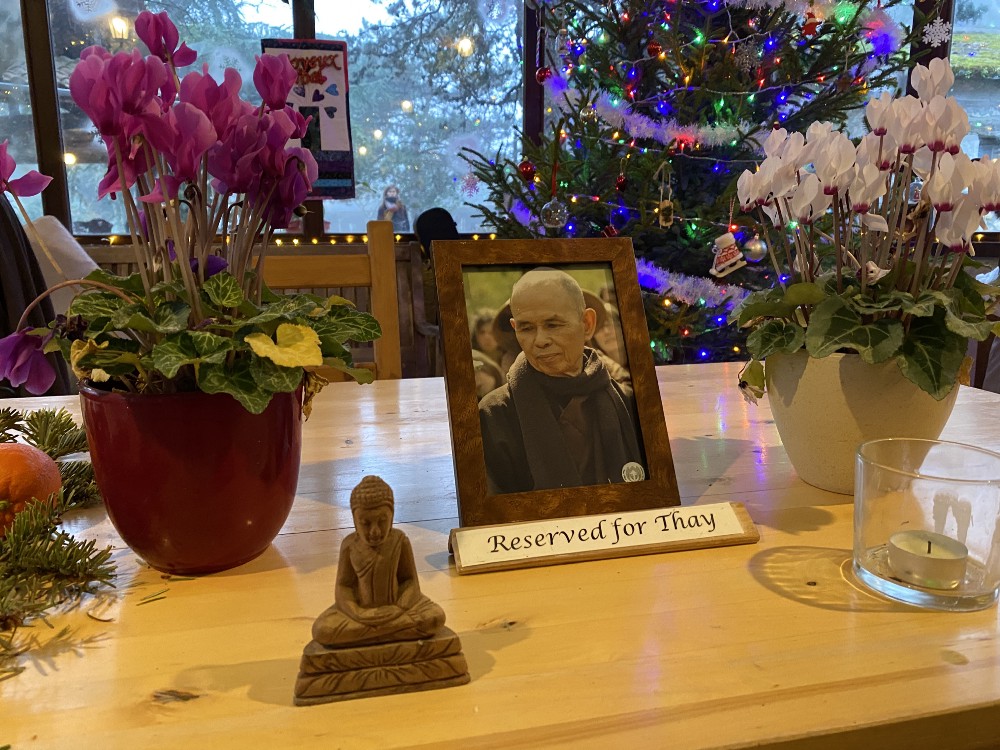 A picture of Thich Nhat Hanh sits at the head of the table in the dining room of Plum Village’s Upper Hamlet, where he lived until moving back to Vietnam.
A picture of Thich Nhat Hanh sits at the head of the table in the dining room of Plum Village’s Upper Hamlet, where he lived until moving back to Vietnam.
Thay, as followers call him, is one of the most prominent promoters of mindfulness in the West. He is also known for having coined the term “Engaged Buddhism” during the Vietnam War, creating an ethical way of life for young social workers who were addressing the poverty and violence around them. He established Plum Village after being exiled to France for his activism against the war.
Over the years, Plum Village has hosted retreats for refugees, veterans, climate change activists, teachers, people of color, young adults, businesspeople, police, politicians, health care workers and more.
Thich Nhat Hanh’s approach is “Where is the suffering? Let’s have a retreat,” Brother Chân Pháp Dung told me during an interview.
A lotus grows not out of marble but out of the mud, Nhat Hanh is known for saying. The path to enlightenment requires an understanding of suffering.
Fear
Though I was there as a journalist, I, too, brought suffering to Plum Village: fear of societal collapse due to climate change.
My “eco-anxiety” has been exacerbated by motherhood. Nothing brings me more joy than being a mother. But when my first child was born during a hot summer two years ago, I cranked up the air conditioning, worried about her dying of SIDS while I slept next to her.
Then I lay awake, worrying about our emissions’ effect on our planet.
At the same time, babies were being separated from their mothers at the US-Mexico border. I held my own baby tightly and cried. What were we doing to this next generation?
My fear for their future is one reason I wanted to interview Brother Chân Pháp Dung and Sister True Dedication.
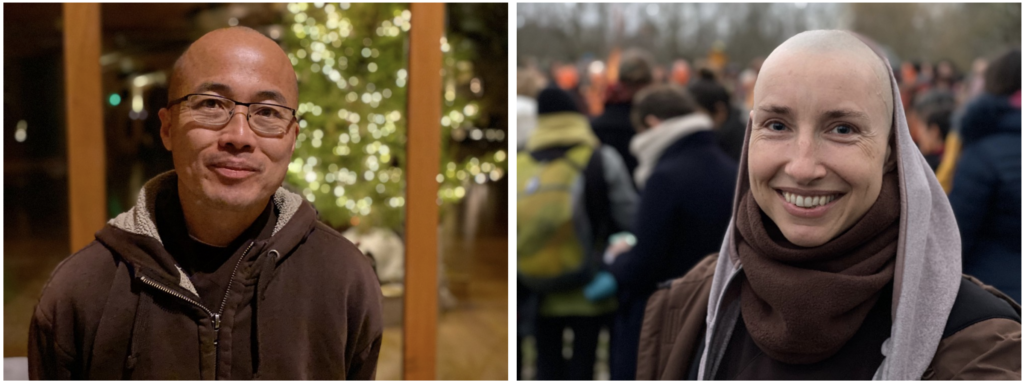 Left: Brother Chân Pháp Dung. Right: Sister True Dedication.
Left: Brother Chân Pháp Dung. Right: Sister True Dedication.
Prior to becoming monastics, Pháp Dung lived through the Vietnam War and Los Angeles’ civil unrest in 1992. True Dedication had been involved in anti-war protests after 9/11. Both represented their community at the Paris Climate Accords.
I wanted to believe that the Plum Village monastics held the secret to how we could survive as a society and reduce the suffering of the most vulnerable.
They told me to come and see for myself.
A Global Ethic
During our weeklong retreat, we practiced sitting meditation and walking mindfully through the French countryside, aware of the crunch of the gravel or squish of the mud under our feet.
We ate vegan food slowly, thinking about our diet’s impact on the world.
We listened to our fellow retreatants describe their experience with the Five Mindfulness Trainings — the protection of life; social justice and generosity; responsible sexual behavior; deep listening and loving speech; and mindful consumption. These practices help those who have committed to them — an estimated 250,000 people — reduce their own and others’ suffering, and notably, not contribute to climate change.
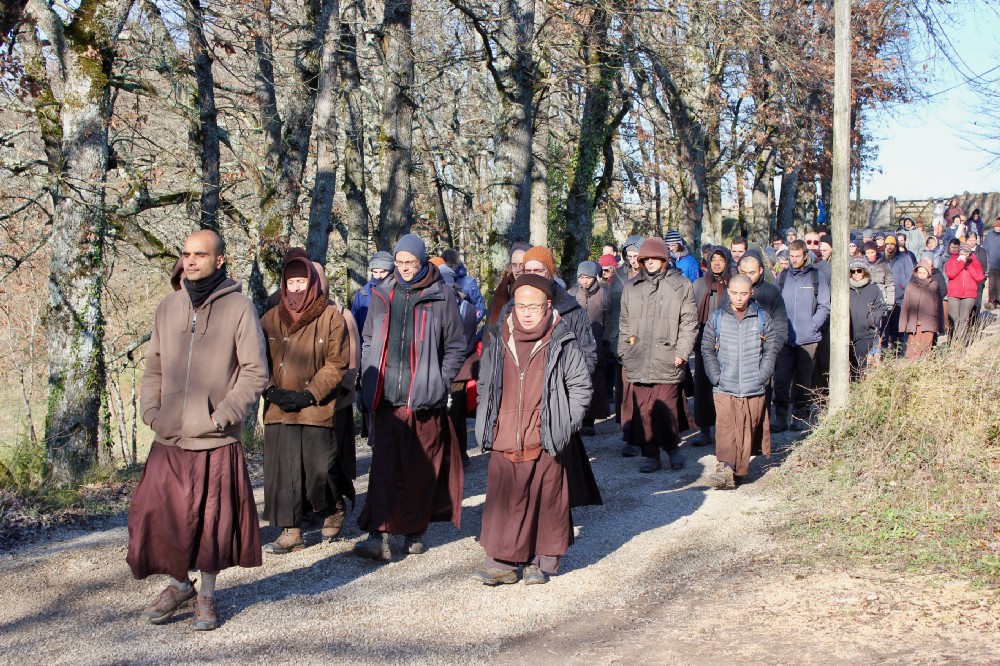 Walking meditation at Plum Village New Year’s retreat 2020.
Walking meditation at Plum Village New Year’s retreat 2020.
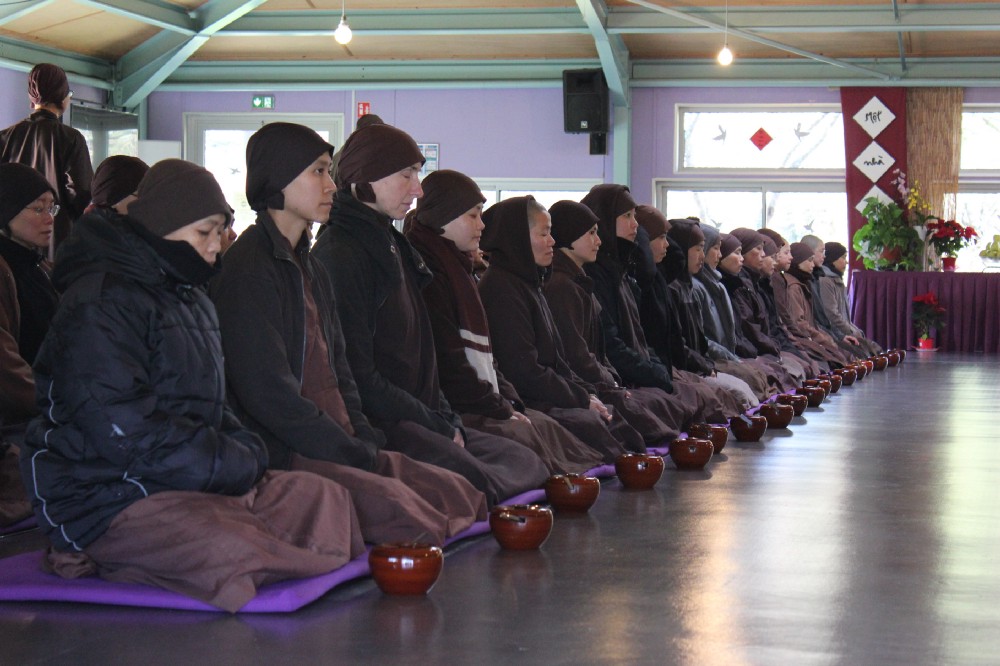 Formal lunch at Plum Village New Year’s retreat 2020.
Formal lunch at Plum Village New Year’s retreat 2020.
When I interviewed Sister True Dedication, she explained Thich Nhat Hanh’s teaching that in order to win peace, activists must first embody peace.
“We’re guided by his insight that systemic change is built on the collective consciousness, and collective consciousness changes by the rubber hitting the road, and people really transforming their way of daily living,” she said.
I had brought my family to the New Year’s retreat seeking a path forward.
Little did I know that a societal collapse would come so soon after we returned home.
Quarantine
As the novel Coronavirus spread throughout the world, offices closed and I started working from home. From afar, I watched Plum Village close its doors to its usual stream of international visitors and transition to online programming.
Brother Pháp Dung, one of the monastics I had interviewed, gave a Dharma talk at the beginning of the pandemic that was shared on YouTube. “This is a moment where the whole planet is required to go on retreat, mandatory and supported by all governments,” he joked.
I laughed not so much at the line as the incongruity of the idea with my current reality. There I was, listening to a spiritual talk in part for myself and in part for work, while doing lunges and watching my daughter play with her stuffed animals. My level of multitasking reached new heights as we hunkered into quarantine.
I dismissed the idea of retreat — certainly it did not apply to working parents — but took heart in Pháp Dung’s social commentary. The pandemic, he said hopefully, was waking us up to the interconnectedness of humanity with each other and all of life.
“The suffering makes us very aware that … the barrier between you and me is very, very fine,” he said.
Pháp Dung also pointed out the origin of the coronavirus — in a wet market filled with animals in unsanitary connections — makes us aware that our lives are intertwined with the health of other species and biosystems.
“The earth is calling. I think she has been calling, but we haven’t been listening,” he said. “I don’t want to play down the sickness and the death that is happening, but humans, we have kind of become a cancer to the planet. And that’s something many of us…don’t want to accept.”
 Calligraphy of “Are you here?” on a path outside of Plum Village.
Calligraphy of “Are you here?” on a path outside of Plum Village.
Pain is part of the human experience, he emphasized. We will be sad when our loved ones get sick and die. And yet suffering also can teach us.
I found hope in the idea that the pandemic might shift attitudes globally and help us chart a new course for humanity and our planet. “It’s a very rare moment because collectively, we are all confronting a threat that is right in front of our door,” Pháp Dung said. “And we only change when we feel threatened, right?”
A Threat
I was a month along in my second pregnancy when the quarantine started. Trusting the officials that life would soon go back to normal, I delayed my first prenatal appointment. But when it became clear that we were shutting down for the long term, I donned a mask and braved the doctors’ office.
Perhaps because I was more nervous about airborne particles than cancer, I felt calm when my doctor told me from underneath her mask that my bladder did not look normal on the ultrasound.
No need to worry about it yet, I thought.
She talked through the usual pregnancy do’s and don’ts, as well as what was known — and not known — about COVID-19 and pregnancy. She paused on occasion to check her cell phone for a message from a urologist. Perhaps I might have been more concerned if I could have seen her face under her mask, but I simply felt grateful to have a doctor who cared enough to text with a colleague when she did not have all the answers.
Two days later, I started my day talking to that doctor over a video call, distracted by the cluttered bedroom from which she was practicing telemedicine. Sometimes she had see cancer in patients my age in California’s Central Valley, where people worked in pesticide plants or in the oil industry, she told me, but I had no risks factors. Nonetheless, she said I should go see one of her colleagues in the hospital for a scope.
Doctors were not seeing just anybody at this time. It began to sink in that this appointment was “essential” business.
By noon, I was in a hospital waiting room. As an hour and then two passed, I felt grateful for my recent training in mindfulness. The waiting room had been stripped of magazines, and I had left my phone in the car so as to avoid touching anything that could collect germs. I sat upright without using the back of the chair, kept my hands in my lap and watched a receptionist sanitize the pens and clipboard used to sign forms attesting that we did not have a cough or fever.
About 10 people sat as far as they could from one another. As patients came and left, I noticed that I was the youngest patient in the room by probably 30 years, and the only female patient. A man who looked to be my dad’s age talked to his companion about his kidney stones. Others arrived on the arms of wives or caretakers, some in wheelchairs and others pushing walkers. I felt out of place.
After such a long wait, the appointment was surprisingly short, and the doctor was matter-of-fact when he said that I, indeed, had a growth in my bladder that should be removed as soon as possible.
What If?
The night before the surgery, I tried focusing on my breath, hoping to sleep. Instead, I thought of those unable to breath because of the coronavirus.
At the hospital the next day, the anesthesiologist advised me to receive a spinal block and be awake for surgery in order to protect my unborn baby.
I turned to my breath again.
In the operating room, the nurses put noise-canceling headphones on me and pressed play on an album of lullabies. I focused my gaze on the baby blue paper sheet they had draped between IV poles so I could not see what was going on. I felt a dull poking in my abdomen, and shifted my attention to my chest rising and falling with each heavy breath.
For the time being, I managed to ward off the “what ifs.”
My doctor’s assistant called two days later. It was cancer, but it was all gone. They wouldn’t need to see me until the baby was born. Perhaps it was shock, or the contrast between the “C” word and her insistence that it was the best possible outcome, but I was left uncertain what to think.
The “what ifs” started pouring in.
What if I had not been pregnant and they did not catch it so early? What if the pain I’m feeling is not just being pregnant, but cancer that they did not catch? What if it comes back? Will I be able to carry this baby to term? Or will I have to have surgery again and radiation and chemo while trying to care for a newborn? What if I die?
In an attempt to distract myself, I turned to social media. I found myself reading stories about the pandemic and climate change. I was “doomscrolling,” I would learn later in the year.
As I read the negative news, I thought of the people the doctor had told me who worked with fertilizers and oil. If I could get cancer with no risk factors, what would become of them? The pandemic already showed how vulnerable farm workers are to disease — and how important they are in our modern urban society. I wondered if someday the privileges that protect my family from pain now will fall away. Do we have the survival skills necessary for a collapse of our food system?
My fears of cancer, coronavirus and climate change fueled a sense of dread, my personal pain melding with our world’s sorrows.
It made me ambivalent about being pregnant. What type of world would my children inherit from us? What would happen to my children if I could not help them navigate a disaster-prone world?
A week later, I was back for a check-up with my obstetrician. In addition to my health scare, I was coming out of one of the most difficult periods of pregnancy, she said.
“You mean the world isn’t coming to an end?” I asked half-jokingly.
The Personal is Political
As I recovered physically and emotionally from my surgery, I revisited Pháp Dung’s pandemic Dharma talk. “The first thing we have to do is take care of ourselves,” he said. “You cannot help, you cannot liberate, you cannot do anything unless you are taking care of yourself.”
Maybe I was wrong to dismiss the idea of making this quarantine into a type of retreat. Yet, there still were no extra hours in the day for meditation.
I thought back to my time at Plum Village and recalled that we spent relatively little time sitting in meditation. Rather, every activity — working, walking, eating, listening to others — was an opportunity to practice mindfulness.
In the opening pages of The Miracle of Mindfulness, the 1976 book that helped establish mindfulness in the West, Thich Nhat Hanh describes a conversation he had with the father of a young child. “I try to find ways of seeing [my child’s] time as my own time,” he quotes the father saying. “The remarkable thing is that now I have unlimited time for myself.”
Even if I could not find time to sit on a cushion and meditate during quarantine, I could put down my phone while watching my daughter play. When I did, I noticed the diligence with which she worked to open and close a Russian nesting doll, her joy in watching butterflies flutter through flowers, and her determination as she picked herself up from falling and said, “Try it again.”
After an hour with her, I no longer felt stressed.
But outside of my toddler-led “retreat” at home, people seemed to be getting restless. Some took to fighting when asked to wear a mask. Religious leaders were politicizing public health directives, insisting on their religious freedom to worship in person. Workers at meat-packing plants were getting infected at a rapid rate. And then on May 25, George Floyd repeated, “I can’t breathe,” more than 20 times as he suffocated under the knee of a police officer.
In hospitals and on the streets, the simple act of breathing was caught up in pain.
I found meaning in supporting colleagues who study and work on racial justice. One colleague told me how Patrisse Cullors, co-founder of Black Lives Matter, was inspired by Thich Nhat Hanh. I could see his teachings echoed in how Cullors and BLM activists seek to heal people while dismantling systemic racism. “My being alive is actually a part of the work,” Cullors told my colleague. “To reclaim our bodies and our health, is a form of resistance, a form of resilience.”
As the summer turned to fall, my colleagues began to note the significance of my due date: November 3. The confluence of my child’s birth with the US election portended good things, they said — a new beginning at home and in our country.
I smiled back at them over Zoom. Yet, I couldn’t help but think about Pháp Dung’s line about humanity being a cancer to the planet and my own cancer. My breath became more labored as my belly grew larger. Was the baby the only thing growing inside me? Could an election heal our planet?
“Each moment we have an opportunity, when we come back to our breath, to come in touch with impermanence, which is another word for life,” Pháp Dung explained in his pandemic Dharma talk. “Life is happening because of in and out, of births and deaths, but it is very easy to forget.”
 Flowers blooming in the winter at Plum Village.
Flowers blooming in the winter at Plum Village.
Ins and Outs
My son arrived a day before the election. I found myself holding my own breath at night in order to listen to him, fearful of both SIDS and COVID-19.
Like much of the country, I held my breath checking election results, fearful that the results could doom our chances to protect our children’s future.
A few weeks later, I followed the direction of the CT scanner and held my breath as it looked for cancer. It was still in my bladder but thankfully had not spread. It remains a manageable, if scary, condition.
In and out, births and deaths. Impermanence still felt like a threat rather than another word for life.
In my last interview with the monastics at Plum Village, I talked with Sister True Dedication in her office, a one-room building heated by a fuel-efficient wood stove. A clock chimed with birdsong, causing us to pause our conversation mid-sentence for a moment of mindfulness.
She told how she had gone from being a Cambridge graduate with a boyfriend and a job at the BBC to entering the life of a Buddhist monastic. She shared her frustrations with trying to create a positive change in society from within a major media organization, and how she had learned to balance contemplation and action under Thich Nhat Hanh and Sister Chan Khong, his first fully-ordained monastic disciple and director of his humanitarian work.
I found myself relating to her story. So, as we wrapped up our interview, I asked her the question closest to my heart: How does she deal with the urgency of humanity’s situation?
Plum Village would continue to be a beacon of compassion and ethics and a refuge for those pushing for change, she said. Then, she came back to her teacher’s insights on life’s impermanence.
“It’s not a problem for the Earth…it’s a problem for humans,” she said. “If humans can make it, we hope that those humans that survive have wonderful practices for cultivating ethics, compassion, understanding, collaboration, patience, forgiveness.”
If not, she said with a laugh, “Trees have survived a long time, so we hope that the trees can outlive us.”
It is a beautiful thought, yet it makes me wistful. I want my daughter and her baby brother to flourish — and I want to see them do so — without being “a cancer to the planet.”
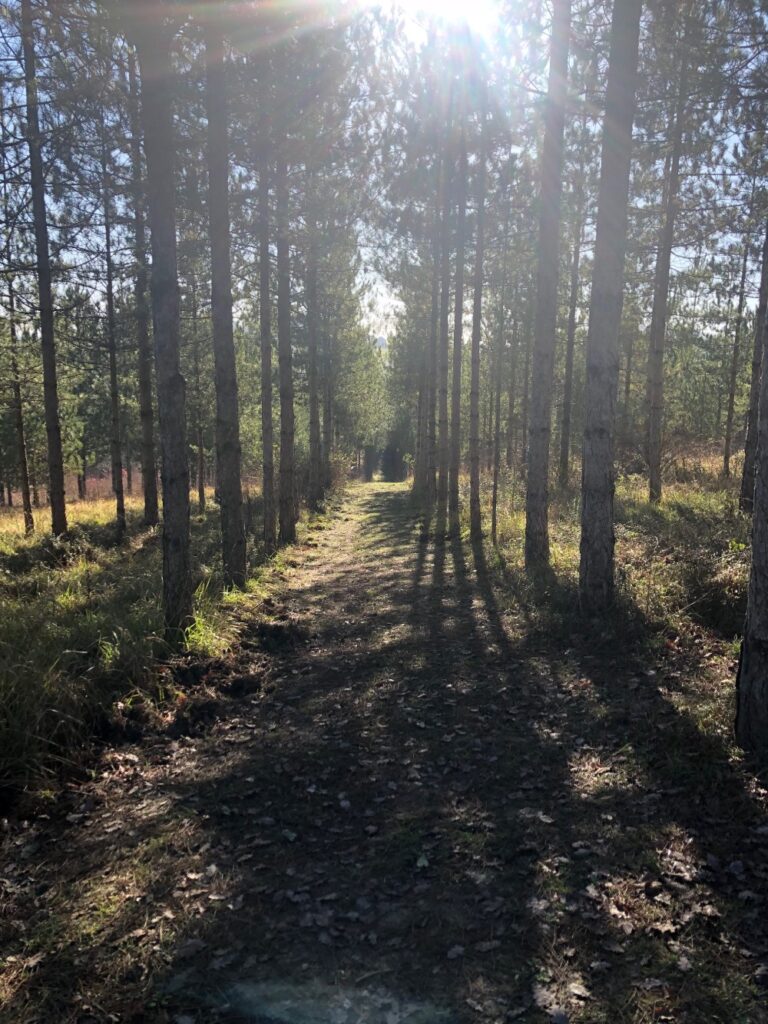 “We hope that the trees can outlive us.”
“We hope that the trees can outlive us.”
I have more work to do to cultivate the qualities I hope to pass along. Change, Thich Nhat Hanh taught, starts within.
Breathing in, I feel the fragility of my breath. Breathing out, I know life is impermanent.
Breathing in, I dwell in this fleeting moment. Breathing out, this is a wonderful moment.
Megan Sweas is the editor and director of communications with the USC Center for Religion and Civic Culture.
